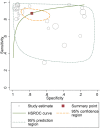Accuracy of autofluorescence in diagnosing oral squamous cell carcinoma and oral potentially malignant disorders: a comparative study with aero-digestive lesions
- PMID: 27416981
- PMCID: PMC4945954
- DOI: 10.1038/srep29943
Accuracy of autofluorescence in diagnosing oral squamous cell carcinoma and oral potentially malignant disorders: a comparative study with aero-digestive lesions
Abstract
Presently, various studies had investigated the accuracy of autofluorescence in diagnosing oral squamous cell carcinoma (OSCC) and oral potentially malignant disorders (OPMD) with diverse conclusions. This study aimed to assess its accuracy for OSCC and OPMD and to investigate its applicability in general dental practice. After a comprehensive literature search, a meta-analysis was conducted to calculate the pooled diagnostic indexes of autofluorescence for premalignant lesions (PML) and malignant lesions (ML) of the oral cavity, lung, esophagus, stomach and colorectum and to compute indexes regarding the detection of OSCC aided by algorithms. Besides, a u test was performed. Twenty-four studies detecting OSCC and OPMD in 2761 lesions were included. This demonstrated that the overall accuracy of autofluorescence for OSCC and OPMD was superior to PML and ML of the lung, esophagus and stomach, slightly inferior to the colorectum. Additionally, the sensitivity and specificity for OSCC and OPMD were 0.89 and 0.8, respectively. Furthermore, the specificity could be remarkably improved by additional algorithms. With relatively high accuracy, autofluorescence could be potentially applied as an adjunct for early diagnosis of OSCC and OPMD. Moreover, approaches such as algorithms could enhance its specificity to ensure its efficacy in primary care.
Figures




References
-
- Parkin D. M., Bray F., Ferlay J. & Pisani P. Global cancer statistics, 2002. CA Cancer J Clin 55, 74–108 (2005). - PubMed
-
- Ferlay J. et al.. Cancer incidence and mortality worldwide: Sources, methods and major patterns in GLOBOCAN 2012. Int J Cancer 136, E359–86 (2015). - PubMed
-
- Grant E., Silver K., Bauld L., Day R. & Warnakulasuriya S. The experiences of young oral cancer patients in Scotland: symptom recognition and delays in seeking professional help. Br Dent J 208, 465–71 (2010). - PubMed
-
- Poh C. F. Heads up!–A call for dentists to screen for oral cancer. J Can Dent Assoc 72, 413–6 (2006). - PubMed
Publication types
MeSH terms
LinkOut - more resources
Full Text Sources
Other Literature Sources
Medical

